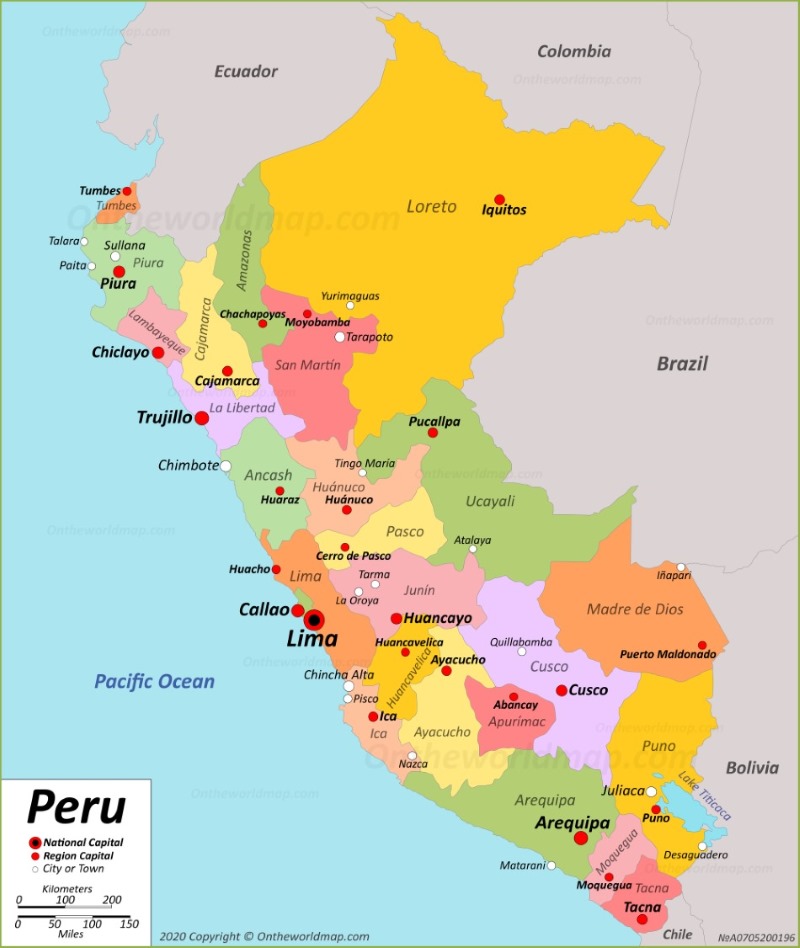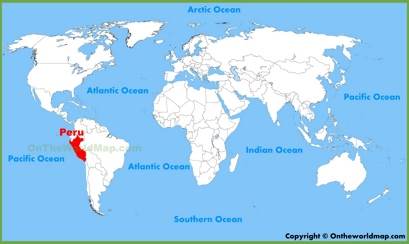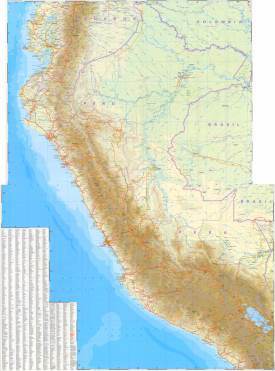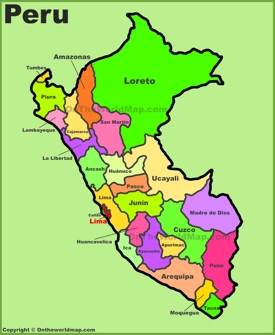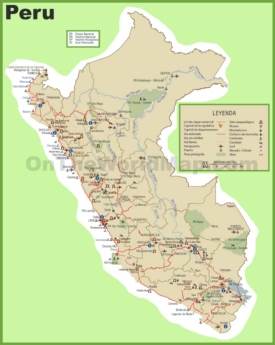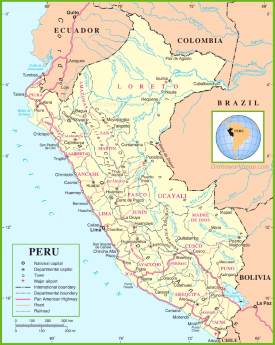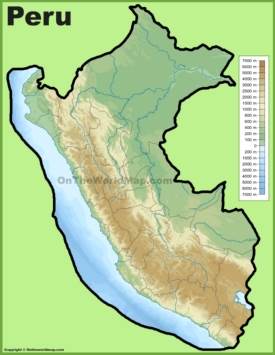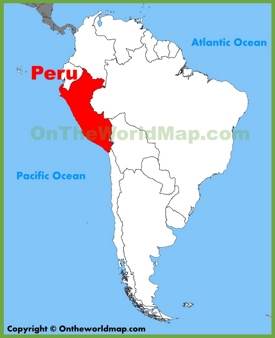Peru Map
Description:
This map shows governmental boundaries of countries; lakes, regions, region capital cities, and major cities and towns in Peru.
You may download, print or use the above map for educational, personal and non-commercial purposes. Attribution is required. For any website, blog, scientific research or e-book, you must place a hyperlink (to this page) with an attribution next to the image used.
Online Map of Peru
About Peru
Peru, officially the Republic of Peru, occupies western South America's central Pacific coast. The country borders Ecuador and Colombia to the north, Brazil to the east, Bolivia to the southeast, and Chile to the south. Peru covers 496,225 square miles (1,285,216 square kilometers) of terrain, which includes parts of the Andes mountains, Amazon Basin rainforest, and the Pacific coast.
The nation has a population of 34 million people, with approximately one-third living in the Lima Metropolitan Area. Lima serves as the capital and largest city, functioning as Peru's political, financial, and cultural center. Other major cities include Arequipa, Trujillo, Chiclayo, and Cusco.
Peru's diverse geography creates three distinct regions: the coast (costa), highlands (sierra), and jungle (selva). The coastal region contains Peru's major cities and ports. The Andes mountains run through the country from north to south, with peaks reaching over 22,000 feet. The Amazon rainforest covers nearly 60% of Peru's territory, making it the fourth largest rainforest country in the world.
The economy relies heavily on mining, manufacturing, agriculture, and tourism. Peru ranks among the world's largest producers of copper, silver, zinc, and gold. Agricultural exports include asparagus, grapes, avocados, and coffee. The country maintains free trade agreements with the United States, China, and the European Union, contributing to steady economic growth over the past two decades.

Tourism represents a significant economic sector, with Machu Picchu serving as Peru's most famous attraction. This 15th-century Inca citadel attracts over a million visitors annually. Other notable destinations include the Nazca Lines, mysterious geoglyphs etched into desert plains; Lake Titicaca, the world's highest navigable lake; and the Colonial-era city center of Cusco. The Amazon rainforest draws eco-tourists to cities like Iquitos and Puerto Maldonado.
Peru's biodiversity includes over 1,800 species of birds, 500 species of mammals, and 300 species of reptiles. The country protects this diversity through numerous national parks and reserves, including Manu National Park and Tambopata National Reserve. The marine ecosystem along Peru's 1,500-mile coastline supports rich fishing grounds, making Peru one of the world's leading fishing nations.
The official languages are Spanish, Quechua, and Aymara. Spanish serves as the primary language in urban areas, while indigenous languages maintain strong presence in rural regions, particularly in the Andean highlands and Amazon basin.
The Facts:| Flag: |

|
| Capital: | Lima |
| Area: | 496,225 sq mi (1,285,216 sq km) |
| Population: | ~ 34,068,259 (2024 estimate) |
| Official language: | Spanish |
| Religion: |
|
| Ethnic groups: |
|
| Currency: | Peruvian sol (PEN) |
| Driving side: | Right |
| Calling code: | +51 |
| Internet TLD: | .pe |
| Time zone: | UTC−05:00 (PET) |
| Gross domestic product (PPP) (2023 estimate): |
|
| Gross domestic product (nominal) (2024 estimate): |
|
Google Map of Peru
List of Largest Cities in Peru (2024)
- Ica (362,400)
- Juliaca (341,700)
- Tacna (327,800)
- Ayacucho (261,200)
- Cajamarca (254,300)
- Huánuco (242,400)
- Chincha Alta (222,500)
- Sullana (209,200)
- Huacho (192,100)
- Tarapoto (178,800)
Main sights in Peru
- Machu Picchu
- Lake Titicaca
- Inca Trail
- Nazca Lines
- Ollantaytambo
- Sacred Valley
- Colca Canyon
- Arequipa's Historical City Center
- Lima's Historic Center
- Huacachina
- Ballestas Islands
- Barranco
- Saqsaywaman
- Sillustani
Regions of Peru
| Region | Capital | Area | Population |
|---|---|---|---|
| Amazonas | Chachapoyas | 39,249 sq km (15,150 sq mi) | 403,000 |
| Ancash | Huaraz | 35,914 sq km (13,863 sq mi) | 1,052,000 |
| Apurímac | Abancay | 20,896 sq km (8,066 sq mi) | 427,000 |
| Arequipa | Arequipa | 63,345 sq km (24,451 sq mi) | 1,150,000 |
| Ayacucho | Ayacucho | 43,815 sq km (16,913 sq mi) | 634,000 |
| Cajamarca | Cajamarca | 33,318 sq km (12,861 sq mi) | 1,370,000 |
| Callao | Callao | 147 sq km (57 sq mi) | 823,000 |
| Cusco | Cusco | 71,986 sq km (27,787 sq mi) | 1,187,000 |
| Huancavelica | Huancavelica | 22,131 sq km (8,543 sq mi) | 462,000 |
| Huánuco | Huánuco | 36,849 sq km (14,224 sq mi) | 746,000 |
| Ica | Ica | 21,328 sq km (8,233 sq mi) | 682,000 |
| Junín | Huancayo | 37,667 sq km (14,539 sq mi) | 1,105,000 |
| La Libertad | Trujillo | 25,500 sq km (9,843 sq mi) | 1,555,000 |
| Lambayeque | Chiclayo | 14,231 sq km (5,493 sq mi) | 1,099,000 |
| Lima | Huacho | 34,802 sq km (13,434 sq mi) | 879,000 |
| Loreto | Iquitos | 368,852 sq km (142,377 sq mi) | 901,000 |
| Madre de Dios | Puerto Maldonado | 85,301 sq km (32,926 sq mi) | 104,000 |
| Moquegua | Moquegua | 15,734 sq km (6,073 sq mi) | 178,000 |
| Pasco | Cerro de Pasco | 25,320 sq km (9,774 sq mi) | 276,000 |
| Piura | Piura | 35,892 sq km (13,854 sq mi) | 1,657,000 |
| Puno | Puno | 66,997 sq km (25,861 sq mi) | 1,263,000 |
| San Martín | Moyobamba | 51,253 sq km (19,784 sq mi) | 678,000 |
| Tacna | Tacna | 16,076 sq km (6,205 sq mi) | 285,000 |
| Tumbes | Tumbes | 4,046 sq km (1,562 sq mi) | 204,000 |
| Ucayali | Pucallpa | 101,831 sq km (39,307 sq mi) | 415,000 |
Geography of Peru
Peru occupies 1,285,216 square kilometers (496,225 sq mi) of western South America, bordering Ecuador, Colombia, Brazil, Bolivia, and Chile. The country contains three distinct geographical regions: the costa (coast), sierra (highlands), and selva (rainforest), which run parallel to the Pacific Ocean.
The costa comprises a narrow strip of desert coastline, stretching 2,414 kilometers along the Pacific Ocean. This region accounts for only 11% of Peru's territory but hosts approximately 52% of the population. The Humboldt Current influences the coastal climate, creating a unique ecosystem with minimal rainfall and moderate temperatures ranging from 14°C to 27°C throughout the year.
The sierra encompasses the Andes Mountains, which divide into two major ranges: Cordillera Occidental and Cordillera Oriental. This region features dramatic elevation changes, with peaks reaching over 6,700 meters above sea level. Mount Huascarán stands as Peru's highest point at 6,768 meters. The sierra experiences two distinct seasons: a dry season (April to October) and a wet season (November to March), with temperatures varying significantly based on altitude.
The selva region covers approximately 60% of Peru's territory and includes part of the Amazon rainforest. This area subdivides into the high jungle (selva alta) and low jungle (selva baja). The climate remains consistently hot and humid, with annual rainfall exceeding 2,000 millimeters. Average temperatures range from 24°C to 32°C, supporting extensive biodiversity.
Major Rivers of Peru
- Amazon River - 4,345 mi (6,992 km)
- Ucayali River - 1,700 mi (2,736 km)
- Putumayo River - 1,610 mi (2,591 km)
- Marañón River - 1,415 mi (2,277 km)
- Napo River - 1,075 mi (1,730 km)
- Huallaga River - 1,038 mi (1,670 km)
- Urubamba River - 724 mi (1,165 km)
- Madre de Dios River - 655 mi (1,054 km)
- Apurímac River - 630 mi (1,014 km)
- Mantaro River - 466 mi (750 km)
- Perené River - 435 mi (700 km)
- Pachitea River - 435 mi (700 km)
- Tambo River - 403 mi (649 km)
- Yavarí River - 400 mi (644 km)
- Tigre River - 398 mi (640 km)
- Corrientes River - 380 mi (612 km)
- Tapiche River - 368 mi (592 km)
- Morona River - 354 mi (570 km)
- Pastaza River - 348 mi (560 km)
- Nanay River - 315 mi (507 km)
Lakes of Peru
- Lake Titicaca - 3,232 sq mi (8,372 km2)
- Lake Junin - 230 sq mi (596 km2)
- Lake Arapa - 53 sq mi (137 km2)
- Lake Parinacochas - 26 sq mi (67 km2)
- Lake Rimachi - 25 sq mi (65 km2)
- Lake Umayo - 19 sq mi (49 km2)
- Lake Sauce - 14 sq mi (36 km2)
- Lake Huacarpay - 13 sq mi (34 km2)
- Lake Sandoval - 12 sq mi (31 km2)
- Lake Quistococha - 11 sq mi (28 km2)
- Lake Langui Layo - 10 sq mi (26 km2)
- Lake Huachucocha - 9 sq mi (23 km2)
- Lake Sibinacocha - 8 sq mi (21 km2)
- Lake Pomacanchi - 8 sq mi (21 km2)
- Lake Huaypo - 7 sq mi (18 km2)
- Lake Piuray - 7 sq mi (18 km2)
- Lake Yarinacocha - 6 sq mi (16 km2)
- Lake Valencia - 6 sq mi (16 km2)
- Lake Lauricocha - 5 sq mi (13 km2)
- Lake Huascacocha - 5 sq mi (13 km2)
The 20 highest Mountains in Peru
- Huascarán - 22,205 ft (6,768 m)
- Yerupajá - 21,768 ft (6,634 m)
- Coropuna - 21,079 ft (6,425 m)
- Huandoy - 20,981 ft (6,395 m)
- Ausangate - 20,945 ft (6,384 m)
- Salkantay - 20,574 ft (6,271 m)
- Chopicalqui - 20,817 ft (6,345 m)
- Ampato - 20,630 ft (6,288 m)
- Carnicero - 20,535 ft (6,259 m)
- Ranrapalca - 20,217 ft (6,162 m)
- Chachani - 19,872 ft (6,057 m)
- Siula Grande - 19,849 ft (6,050 m)
- Alpamayo - 19,511 ft (5,947 m)
- Quitaraju - 19,459 ft (5,931 m)
- Huayna Potosí - 19,439 ft (5,925 m)
- Pichu Pichu - 19,098 ft (5,822 m)
- Rasac - 19,094 ft (5,820 m)
- Jirishanca - 19,029 ft (5,801 m)
- Tocllaraju - 19,019 ft (5,798 m)
- Artesonraju - 19,006 ft (5,794 m)
Brief History of Peru
The history of Peru spans over 11,000 years, beginning with the arrival of the first hunter-gatherers to the Andes region. The earliest known complex society, the Norte Chico civilization, emerged around 3000 BCE along Peru's central coast, establishing sophisticated agricultural practices and architectural innovations.
Between 100 BCE and 800 CE, multiple pre-Inca civilizations flourished throughout Peru. The Moche civilization dominated the northern coast with advanced ceramic art and complex irrigation systems. The Nazca people created enormous ground drawings in the southern desert, while the Wari Empire established the first regional state in the Andes, implementing sophisticated administrative systems and road networks.
The Inca Empire arose in the 13th century, expanding from their capital Cusco to create the largest pre-Columbian empire in the Americas. The Incas developed sophisticated agricultural terracing, astronomical knowledge, and a complex road system called Qhapaq Ñan. Their empire lasted until the Spanish conquest in 1532, led by Francisco Pizarro.
Spanish colonial rule transformed Peru into a vital center of the Spanish Empire, establishing the Viceroyalty of Peru in 1542. Lima became the capital and principal city of South America. The colonial period witnessed extensive silver mining, the introduction of European agriculture, and significant demographic changes due to disease and exploitation of indigenous populations.
Peru declared independence from Spain in 1821, led by José de San Martín. The 19th century saw political instability, territorial conflicts, and economic transformation through guano exports. The War of the Pacific (1879-1883) against Chile resulted in significant territorial losses. The 20th century brought periods of military rule, democratic transitions, and economic reforms. Modern Peru emerged as a democratic republic in 1980, despite challenges from internal conflicts and economic crises.

